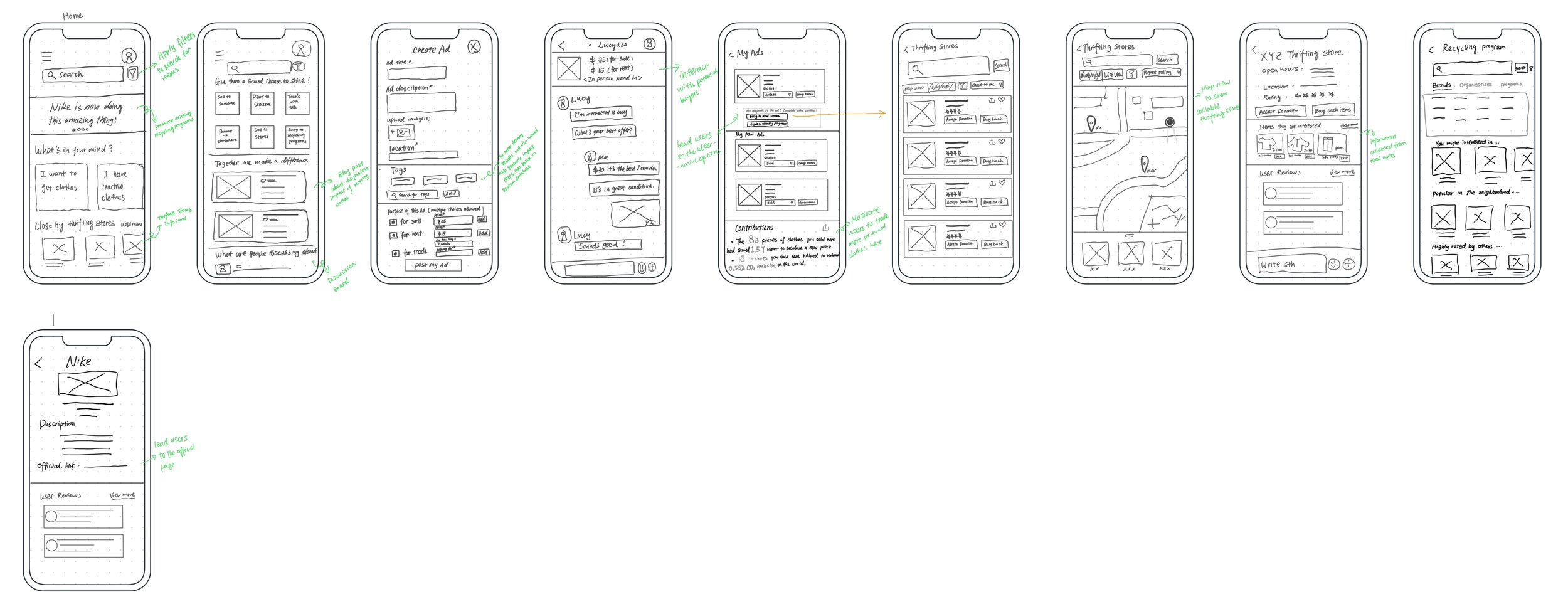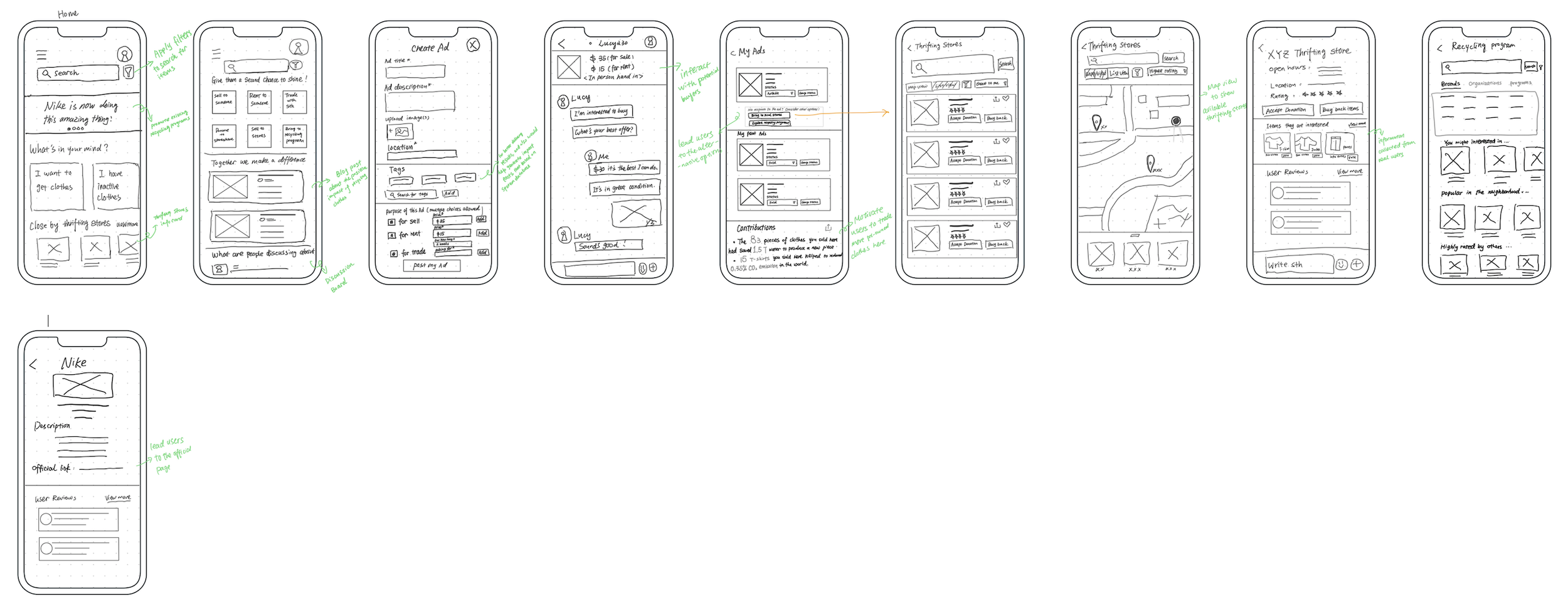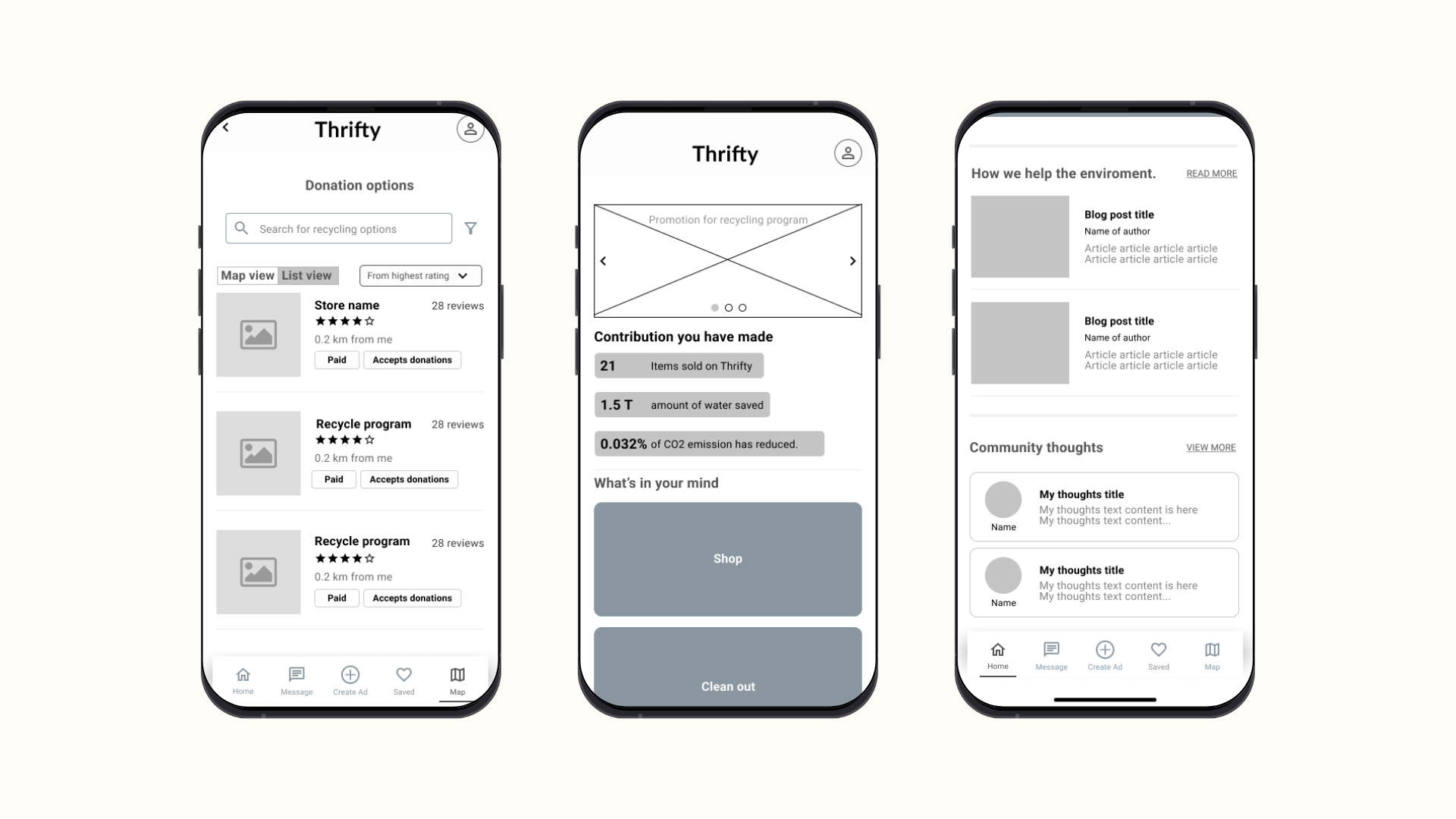
Thrifty
As the capstone project for my Master's degree in mid-summer 2022, I collaborated with three team members to develop a practical, effective, and highly motivating application. This app is designed to encourage consumers to focus on reusing and recycling clothing.
Role & Team
Teamed up with 3 team members, We worked together from business problem analysis to UX research and design/
Duration
2 Weeks (May 2022)
Overview
"Thrifty" is our school capstone project—a collaborative effort by my team of three members. We set out to tackle current sustainability challenges by creating a practical, user-focused app that benefits both businesses and consumers.
Tool
Figma & Miro
Scope
UI/UX, Data and business analysis, Wireframing, Competitive Analysis, Rapid Prototyping, User Flow, Persona

The Urgency of Climate Action
The rise in CO₂ levels in the atmosphere is accelerating global warming and climate change, leading to widespread environmental consequences.
🌍 The Impact on Our Planet:
Increased frequency and intensity of extreme weather events (hurricanes, wildfires, floods).
Rising sea levels, threatening coastal communities.
Disruptions to global food and water supplies, exacerbating scarcity and hunger.
Escalating climate migration, as populations are forced to relocate due to uninhabitable conditions.
While energy and transportation are often seen as the biggest contributors, nearly every industry has a carbon footprint. Addressing this challenge requires systemic changes across multiple sectors, including fashion and retail.
Existing Solutions & Strategies
To mitigate climate change, businesses and governments are exploring several key strategies:
1️⃣ Carbon Offsets
A carbon offset is a reduction in CO₂ emissions that compensates for emissions produced elsewhere. This includes:
✅ Reforestation projects – Planting trees to absorb CO₂.
✅ Investment in renewable energy – Supporting wind, solar, and hydropower.
✅ Carbon credit programs – Allowing companies to "neutralize" emissions by funding sustainability efforts.
2️⃣ Carbon Capture & Utilization (CCU)
Instead of just reducing emissions, capturing and transforming CO₂ offers a proactive approach:
🔹 Direct Air Capture (DAC): Extracting CO₂ from the atmosphere and storing it underground.
🔹 CO₂ to Products: Converting captured CO₂ into fuels, building materials, and even clothing fibers.
3️⃣ Reducing Greenhouse Gas Emissions at the Source
Industries are working on reducing emissions directly through:
🚗 Electrification of transport (EVs, public transit innovations).
🏭 Sustainable manufacturing (energy-efficient processes, lower-waste production).
👕 Circular economy in fashion (recycling textiles, reducing fast fashion waste).
The Key Problem Statement
How might businesses partner with their customers to reach their carbon offset goals and drive brand loyalty?
Problem Defination
-
Location
North America
-
Industry
Clothing / Fashion
-
Format
Mobile app platform
Background Research
1. The Climate Crisis & Fashion Industry’s Role
The rise in CO₂ levels is accelerating global warming and climate change, leading to widespread environmental and societal challenges:
🌍 Environmental Consequences:
More frequent and severe extreme weather events (wildfires, hurricanes, floods).
Rising sea levels, threatening coastal communities.
Disruptions to global food and water supplies, increasing resource scarcity.
Escalating climate migration, forcing populations to relocate due to unlivable conditions.
While industries such as energy and transportation are often blamed for emissions, fashion is a significant but overlooked contributor:
👕 The Fashion Industry’s Carbon Footprint
The fashion industry is responsible for 10% of global carbon emissions—more than aviation and shipping combined.
Over 92 million tons of textile waste are generated annually.
Fast fashion encourages disposable clothing habits, exacerbating the waste problem.
2. The Business Challenge: Balancing Sustainability & Profitability
Businesses today face a complex challenge:
✅ Meeting carbon reduction targets while maintaining profitability.
✅ Enhancing brand loyalty through sustainability-driven initiatives.
✅ Encouraging consumer participation in carbon reduction without imposing additional costs.
However, the current sustainability landscape is full of challenges:
🚨 Carbon offset costs – Many businesses shift the costs of sustainability efforts onto consumers.
🚨 Rising production expenses – Supply chain disruptions increase material costs.
🚨 Low consumer engagement – Many customers support sustainability in theory but lack motivation to take action.
Market & Competitive Landscape
To assess existing solutions and market gaps, we conducted a competitive analysis of platforms promoting circular fashion and sustainability-driven consumer engagement:
Envision
Sketches


Personas

Low-fi Prototype
Home - Main Page
Key Elements & Functionality:
Navigation Bar (Bottom Menu): Provides access to Home, Messages, Create Ad, Saved Items, and Account for seamless interaction.
Search & Filter Bar (Top): Allows users to find clothing items or thrift stores, with a filter option for refined searches.
Promotional Carousel: Highlights recycling programs, promotions, or sustainability initiatives, with swipe functionality for multiple banners.
User Action Section ("What's in your mind")
"I want to get clothes" – Leads to browsing thrift store listings or second-hand clothing options.
"I have inactive clothes" – Guides users to donation, recycling, or resale options.
Thrift Store Discovery Section: Displays nearby thrift stores with distance indicators, ratings, and basic store details. A "VIEW MORE" option allows users to explore additional stores.
Comparison Tool
Payment Calculator
Usability Test
Moderated Testing
Objectives
Understand the end-to-end journey of how users purchase a car
Assess awareness & discoverability of the tools(filter/sort, comparison & payment calculator)
Assess comprehension of content & tools
-
Screening
12 Participants
Age?
Occupation?
Geographic Location?
Already a car owner?
-
Task 1: First Time User
You have made up your mind to purchase a car, This is the first time you are on the Jeep SNI Tool website.
Your goal is to navigate through these interfaces and get familiar with what information and tools are provided.
-
Task 2: Come back to refine my list
After narrowing down to the 3-5 options last time, You are hoping to select the one you are most likely to buy.
Your goal is to navigate through these interfaces and finalize the 3-5 vehicle options you want to select from.
-
Task 3: I am deciding “the one”
You have "the one" in mind, what will you consider doing next? Is there any information you still want to know?
Your goal is to navigate through these interfaces to prepare to purchase the vehicle you have selected.
Testing Results
What People Are Saying
Photo Gallery
All of the participants tried to flip through the vehicle photo gallery.
All of the participants interacted with the tool to enlarge the vehicle pictures.
10 out of 12 participants mentioned the actual photos of the vehicle's interior and exterior would be helpful.
“Comparison/Calculator is not obvious”
8 out of 12 users reported that the compare and payment calculator tools are difficult to notice while feel they are helpful after being pointed out to them.
Filter & Sort
Half of the users interact heavily with the Filter & Sort tool
Unknown…
5 out of 12 users reported that they hesitate to click on any buttons if they are unclear about what they will be redirected to.
The signs are observed more when it comes to elderly audiences.

Hi-fi Prototype

Design Changes
-
Enlarge the picture gallery section on each page
Add in “Zoom in/out” function to allow users to see more details if needed
-
Allowing more space to be saved
-
By enlarging the text and icon sizes
-
Making essential information appear before the user clicks on to the buttons
Releasing some of the tools out of drop-down panels if necessary
















